What to do if LEDs are still out after reapplying power to my Lincoln Electric Welding System?
- SSharon MckeeAug 15, 2025
If the LEDs are still not illuminated after power is reapplied, the suggested solution is to replace the firing PCB.
What to do if LEDs are still out after reapplying power to my Lincoln Electric Welding System?
If the LEDs are still not illuminated after power is reapplied, the suggested solution is to replace the firing PCB.
How to troubleshoot if LEDs 7, 8, and 9 don't light up during power-on tests for Lincoln Electric DC-655?
If LEDs 7, 8, and 9 do not illuminate during the power-on tests, turn off the machine and unplug P5 from the firing board. Then, turn the machine back on and check the AC voltage between the following pins: * LED 7: Check AC voltage between P5 pins 15 & 16. The voltage should be approximately 32VAC. * LED 8: Check AC voltage between P5 pins 7 & 8. The voltage should be approximately 32VAC. * LED 9: Check AC voltage between P5 pins 5 & 6. The voltage should be approximately 32VAC.
What does it mean if LED6 is ON but LEDs 2, 3, 4, or 5 are not ON in my Lincoln Electric Welding System?
If LED6 is illuminated, but LEDs 2, 3, 4, or 5 are not, the suggested solution is to replace the PCB.
What to do if LED1 is ON but the Lincoln Electric DC-655 Welding System is cold?
If LED1 is ON, but the machine remains cold, the suggested solution is to replace the PCB.
What does it mean if LED3 is ON but my Lincoln Electric DC-655 Welding System remains cold?
If LED3 is ON but the machine is cold, the suggested solution is to replace the PCB.
What should I do if LED2 is ON, but my Lincoln Electric Welding System isn't drawing more than 40 amps?
If LED2 is ON, but the machine is not drawing more than 40 amps, the suggested solution is to replace the PCB.
What to do if LED4 is ON but the Thermal Fan Thermistor is not open on my Lincoln Electric DC-655?
If LED4 is ON but the Thermal Fan Thermistor is not open, the suggested solution is to replace the PCB.
What should I do if the Thermal Protection light is not ON, but LED5 is ON in my Lincoln Electric Welding System?
If the Thermal Protection light is not ON and LED5 is ON, the suggested solution is to replace the PCB.
What to do if there's no voltage for LEDs 7, 8, and 9 on my Lincoln Electric DC-655?
If voltages were not present for LEDs 7, 8, and 9, check the wiring back to the auxiliary windings for a possible open.
Emphasizes user responsibility for safe operation and maintenance by reading the manual.
Alerts to chemicals in engine exhaust known to cause cancer, birth defects, or reproductive harm.
Warns about hazards of arc welding and advises consulting doctors for pacemaker wearers.
Details potential hazards of EMF, especially for pacemaker users, and provides mitigation procedures.
Details dangers of electric shock during welding and essential safety measures.
Advises on protecting eyes and skin from arc rays using shields and appropriate clothing.
Warns about hazardous fumes and gases, emphasizing ventilation and proper respiratory protection.
Highlights fire and explosion risks from welding sparks and provides preventative measures.
Warns about the danger of cylinder explosion if damaged and provides safe handling guidelines.
Provides safety instructions for electrically powered equipment, including grounding and power disconnection.
Instructs to inspect equipment for damage upon receipt and record identification details.
Details technical data including input voltage, current, output ratings, and physical dimensions.
Provides guidance on selecting appropriate input wire and fuse sizes based on voltage and current.
Explains various graphic symbols found on the machine's rating plate for identification and compliance.
Highlights critical safety warnings and requirements before performing installation procedures.
Advises on choosing an appropriate location for the welder to ensure proper cooling and prevent overheating.
Details procedures for connecting the machine to the input power supply, including voltage and phase checks.
Explains the importance and method for grounding the machine frame for electrical safety.
Provides instructions for connecting the three-phase AC power supply to the machine.
Guides on how to reconnect the machine for different input voltages using internal links.
Details how to connect electrode and work cables and recommends appropriate cable sizes.
Explains the use of the low inductance terminal for specific CV welding procedures.
Describes connections for auxiliary power, wire feeders, and remote controls.
Details the specifications and protection for 115VAC and 230VAC auxiliary receptacles.
Explains connections for wire feeder control cables using terminal strips for various functions.
Provides essential safety warnings regarding electric shock, fumes, sparks, and arc rays during operation.
Offers a brief overview of the DC-655 and lists the available models.
Suggests suitable welding processes and compatible equipment for use with the DC-655.
Highlights key features and benefits of the DC-655, including controls, protection, and power options.
Details the output and duty cycle ratings of the DC-655 for different amperage and voltage levels.
Identifies and explains the function of each control and switch on the DC-655 front panel.
Explains the electronic current limiting feature in CV modes for improved arc stability.
Details the Arc Force control for CC welding and its suitability for air carbon arc gouging.
Describes thermal protection, circuit breakers, and their roles in safeguarding the machine.
Details the 42VAC, 115VAC, and 220VAC auxiliary power sources and their circuit protection.
Guides on connecting welding cables to the positive and negative output terminals.
Explains the conditions that trigger machine shutdown, including thermal, overload, and fault conditions.
Details various shutdown conditions like thermal overload, over current, and remote control faults.
Explains the energy-saving idle shut down timer and its configuration.
Provides notes on welding performance, specifically regarding the low inductance terminal usage.
Explains how to adjust CV mode current limiting between 'Hi' and 'Lo' settings.
Details the CC mode hot start feature and the adjustment of arc force for better arc control.
Lists Lincoln wire feeders compatible with the DC-655 power source.
Describes optional kits for enhancing machine functionality, such as meters and feeder kits.
Explains optional switches for dual process selection and kits for paralleling machines.
Outlines essential safety precautions to be followed before performing any maintenance tasks.
Provides basic maintenance advice, including fan care, cleaning, and cable inspection.
Addresses problems related to the input contactor, including chatter and failure to operate.
Troubleshoots scenarios where the machine has power but no welding output.
Covers problems with control signals, output regulation, and maximum output.
Provides solutions for issues related to poor arc striking with semi-automatic or automatic wire feeders.
Addresses issues like variable/sluggish arcs and problems with local or remote control functions.
Troubleshoots machines that won't weld (low OCV) or wire feeders that fail to power on.
Addresses poor arc characteristics and problems with the 115VAC receptacle not working.
Covers scenarios where the thermal protection light is on but the fan isn't running, or the fan runs continuously.
Troubleshoots issues with digital meters not lighting up or displaying erratically.
Addresses problems with digital ammeters, analog meters, and the 220VAC receptacle.
Provides guidance on troubleshooting the firing PC board using LED indicators and voltage checks.
Details how to troubleshoot the control PC board by interpreting LED indicators for various machine states.
Guides troubleshooting for the thermal fan/snubber PC board, focusing on LED indicators and fan operation.
Illustrates the wiring connections between the LN-7 wire feeder and the DC-655 power source.
Shows wiring connections for LN-8 or LN-9 wire feeders to the DC-655 power source.
Illustrates connections for NA-3, LT-5, or LT-7 automatic feeders to the DC-655 power source.
Details wiring connections for NA-5 or NA-5R automatic feeders to the DC-655 power source.
Shows wiring for DH-10 or LN-10 wire feeders using a 14-pin Amphenol connector.
Provides detailed dimensions of the DC-655 when fitted with the K817P undercarriage.
Provides detailed dimensions of the DC-655 when fitted with the K842 undercarriage.
Details how to order Lincoln Electric publications and catalogs, including payment methods.
Presents essential safety warnings in multiple languages for user protection.
Provides multilingual safety advice on ventilation, power off for servicing, and panel guards.
Emphasizes user responsibility for safe operation and maintenance by reading the manual.
Alerts to chemicals in engine exhaust known to cause cancer, birth defects, or reproductive harm.
Warns about hazards of arc welding and advises consulting doctors for pacemaker wearers.
Details potential hazards of EMF, especially for pacemaker users, and provides mitigation procedures.
Details dangers of electric shock during welding and essential safety measures.
Advises on protecting eyes and skin from arc rays using shields and appropriate clothing.
Warns about hazardous fumes and gases, emphasizing ventilation and proper respiratory protection.
Highlights fire and explosion risks from welding sparks and provides preventative measures.
Warns about the danger of cylinder explosion if damaged and provides safe handling guidelines.
Provides safety instructions for electrically powered equipment, including grounding and power disconnection.
Instructs to inspect equipment for damage upon receipt and record identification details.
Details technical data including input voltage, current, output ratings, and physical dimensions.
Provides guidance on selecting appropriate input wire and fuse sizes based on voltage and current.
Explains various graphic symbols found on the machine's rating plate for identification and compliance.
Highlights critical safety warnings and requirements before performing installation procedures.
Advises on choosing an appropriate location for the welder to ensure proper cooling and prevent overheating.
Details procedures for connecting the machine to the input power supply, including voltage and phase checks.
Explains the importance and method for grounding the machine frame for electrical safety.
Provides instructions for connecting the three-phase AC power supply to the machine.
Guides on how to reconnect the machine for different input voltages using internal links.
Details how to connect electrode and work cables and recommends appropriate cable sizes.
Explains the use of the low inductance terminal for specific CV welding procedures.
Describes connections for auxiliary power, wire feeders, and remote controls.
Details the specifications and protection for 115VAC and 230VAC auxiliary receptacles.
Explains connections for wire feeder control cables using terminal strips for various functions.
Provides essential safety warnings regarding electric shock, fumes, sparks, and arc rays during operation.
Offers a brief overview of the DC-655 and lists the available models.
Suggests suitable welding processes and compatible equipment for use with the DC-655.
Highlights key features and benefits of the DC-655, including controls, protection, and power options.
Details the output and duty cycle ratings of the DC-655 for different amperage and voltage levels.
Identifies and explains the function of each control and switch on the DC-655 front panel.
Explains the electronic current limiting feature in CV modes for improved arc stability.
Details the Arc Force control for CC welding and its suitability for air carbon arc gouging.
Describes thermal protection, circuit breakers, and their roles in safeguarding the machine.
Details the 42VAC, 115VAC, and 220VAC auxiliary power sources and their circuit protection.
Guides on connecting welding cables to the positive and negative output terminals.
Explains the conditions that trigger machine shutdown, including thermal, overload, and fault conditions.
Details various shutdown conditions like thermal overload, over current, and remote control faults.
Explains the energy-saving idle shut down timer and its configuration.
Provides notes on welding performance, specifically regarding the low inductance terminal usage.
Explains how to adjust CV mode current limiting between 'Hi' and 'Lo' settings.
Details the CC mode hot start feature and the adjustment of arc force for better arc control.
Lists Lincoln wire feeders compatible with the DC-655 power source.
Describes optional kits for enhancing machine functionality, such as meters and feeder kits.
Explains optional switches for dual process selection and kits for paralleling machines.
Outlines essential safety precautions to be followed before performing any maintenance tasks.
Provides basic maintenance advice, including fan care, cleaning, and cable inspection.
Addresses problems related to the input contactor, including chatter and failure to operate.
Troubleshoots scenarios where the machine has power but no welding output.
Covers problems with control signals, output regulation, and maximum output.
Provides solutions for issues related to poor arc striking with semi-automatic or automatic wire feeders.
Addresses issues like variable/sluggish arcs and problems with local or remote control functions.
Troubleshoots machines that won't weld (low OCV) or wire feeders that fail to power on.
Addresses poor arc characteristics and problems with the 115VAC receptacle not working.
Covers scenarios where the thermal protection light is on but the fan isn't running, or the fan runs continuously.
Troubleshoots issues with digital meters not lighting up or displaying erratically.
Addresses problems with digital ammeters, analog meters, and the 220VAC receptacle.
Provides guidance on troubleshooting the firing PC board using LED indicators and voltage checks.
Details how to troubleshoot the control PC board by interpreting LED indicators for various machine states.
Guides troubleshooting for the thermal fan/snubber PC board, focusing on LED indicators and fan operation.
Illustrates the wiring connections between the LN-7 wire feeder and the DC-655 power source.
Shows wiring connections for LN-8 or LN-9 wire feeders to the DC-655 power source.
Illustrates connections for NA-3, LT-5, or LT-7 automatic feeders to the DC-655 power source.
Details wiring connections for NA-5 or NA-5R automatic feeders to the DC-655 power source.
Shows wiring for DH-10 or LN-10 wire feeders using a 14-pin Amphenol connector.
Provides detailed dimensions of the DC-655 when fitted with the K817P undercarriage.
Provides detailed dimensions of the DC-655 when fitted with the K842 undercarriage.
Details how to order Lincoln Electric publications and catalogs, including payment methods.
Presents essential safety warnings in multiple languages for user protection.
Provides multilingual safety advice on ventilation, power off for servicing, and panel guards.
| Input Voltage | 230/460 V |
|---|---|
| Input Frequency | 50/60 Hz |
| Duty Cycle | 100% at 500 A |
| Open Circuit Voltage | 80 V |
| Protection Class | IP23 |
| Processes | Stick, TIG, MIG, Flux-Cored |
| Welding Process | TIG, MIG, Stick |
| Weight | 492 lbs (223 kg) |
| Dimensions (H x W x D) | 34.3 in x 25.0 in x 35.0 in (871 mm x 635 mm x 889 mm) |
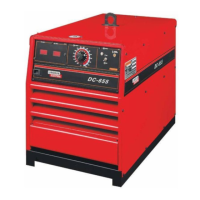


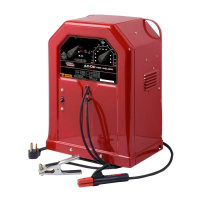
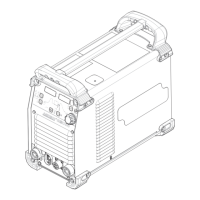
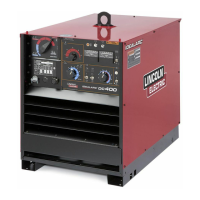


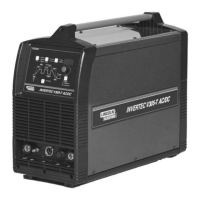

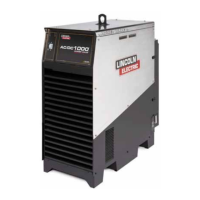
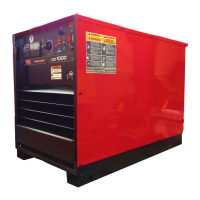
